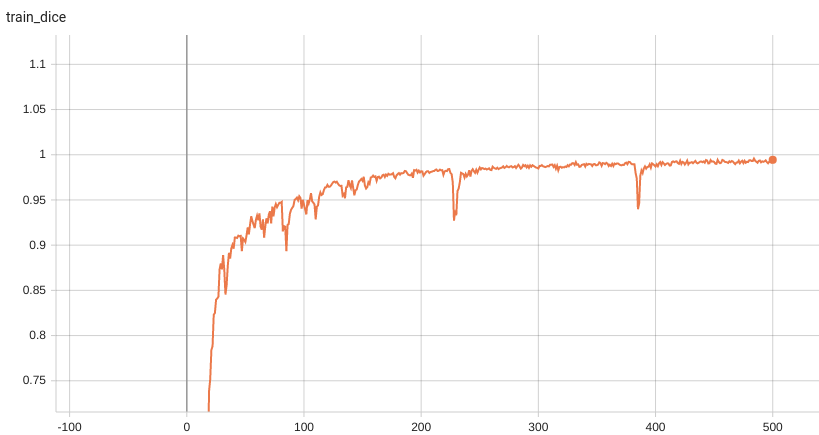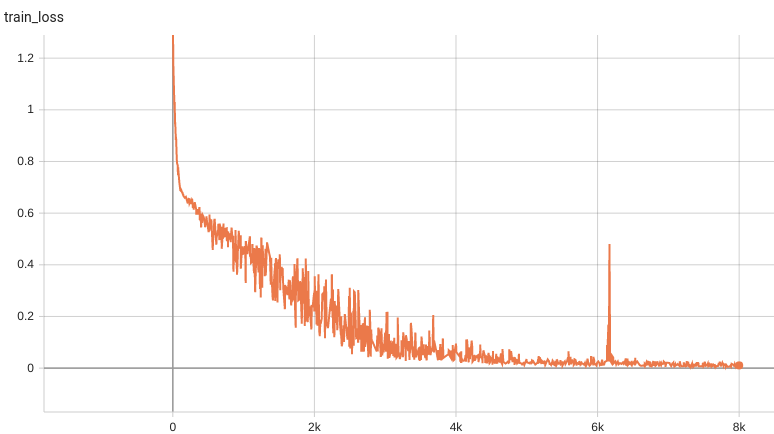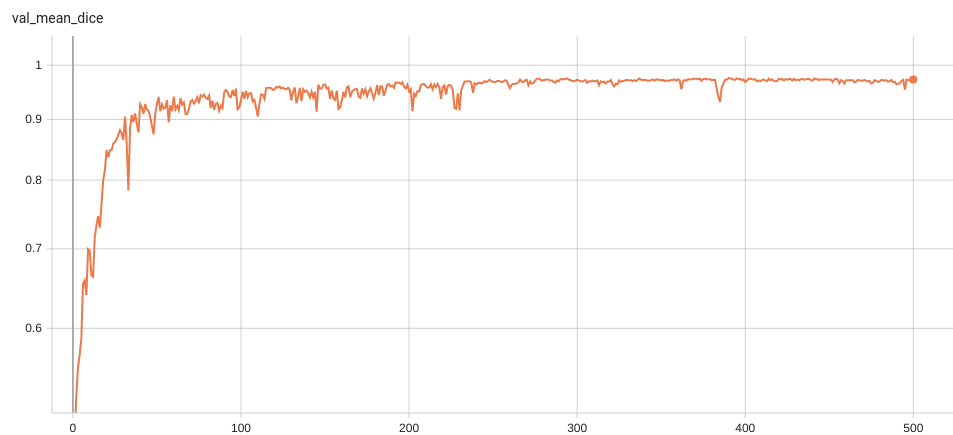| # Model Overview | |
| A pre-trained model for 3D segmentation of the spleen organ from CT images using DeepEdit. | |
| DeepEdit is an algorithm that combines the power of two models in one single architecture. It allows the user to perform inference as a standard segmentation method (i.e., UNet) and interactively segment part of an image using clicks [2]. DeepEdit aims to facilitate the user experience and, at the same time, develop new active learning techniques. | |
| The model was trained on 32 images and validated on 9 images. | |
| ## Data | |
| The training dataset is the Spleen Task from the Medical Segmentation Decathalon. Users can find more details on the datasets at http://medicaldecathlon.com/. | |
| - Target: Spleen | |
| - Modality: CT | |
| - Size: 61 3D volumes (41 Training + 20 Testing) | |
| - Source: Memorial Sloan Kettering Cancer Center | |
| - Challenge: Large-ranging foreground size | |
| ## Training configuration | |
| The training as performed with the following: | |
| - GPU: at least 12GB of GPU memory | |
| - Actual Model Input: 128 x 128 x 128 | |
| - AMP: True | |
| - Optimizer: Adam | |
| - Learning Rate: 1e-4 | |
| - Loss: DiceCELoss | |
| ### Input | |
| Three channels | |
| - CT image | |
| - Spleen Segment | |
| - Background Segment | |
| ### Output | |
| Two channels | |
| - Label 1: spleen | |
| - Label 0: everything else | |
| ## Performance | |
| Dice score is used for evaluating the performance of the model. This model achieves a dice score of 0.97, depending on the number of simulated clicks. | |
| #### Training Dice | |
|  | |
| #### Training Loss | |
|  | |
| #### Validation Dice | |
|  | |
| #### TensorRT speedup | |
| The `spleen_deepedit_annotation` bundle supports acceleration with TensorRT through the ONNX-TensorRT method. The table below displays the speedup ratios observed on an A100 80G GPU. | |
| | method | torch_fp32(ms) | torch_amp(ms) | trt_fp32(ms) | trt_fp16(ms) | speedup amp | speedup fp32 | speedup fp16 | amp vs fp16| | |
| | :---: | :---: | :---: | :---: | :---: | :---: | :---: | :---: | :---: | | |
| | model computation | 147.52 | 40.32 | 28.87 | 11.94 | 3.66 | 5.11 | 12.36 | 3.38 | | |
| | end2end |1292.39 | 1204.62 | 1168.09 | 1149.88 | 1.07 | 1.11 | 1.12 | 1.05 | | |
| Where: | |
| - `model computation` means the speedup ratio of model's inference with a random input without preprocessing and postprocessing | |
| - `end2end` means run the bundle end-to-end with the TensorRT based model. | |
| - `torch_fp32` and `torch_amp` are for the PyTorch models with or without `amp` mode. | |
| - `trt_fp32` and `trt_fp16` are for the TensorRT based models converted in corresponding precision. | |
| - `speedup amp`, `speedup fp32` and `speedup fp16` are the speedup ratios of corresponding models versus the PyTorch float32 model | |
| - `amp vs fp16` is the speedup ratio between the PyTorch amp model and the TensorRT float16 based model. | |
| Currently, the only available method to accelerate this model is through ONNX-TensorRT. However, the Torch-TensorRT method is under development and will be available in the near future. | |
| This result is benchmarked under: | |
| - TensorRT: 8.5.3+cuda11.8 | |
| - Torch-TensorRT Version: 1.4.0 | |
| - CPU Architecture: x86-64 | |
| - OS: ubuntu 20.04 | |
| - Python version:3.8.10 | |
| - CUDA version: 12.0 | |
| - GPU models and configuration: A100 80G | |
| ### Memory Consumption | |
| - Dataset Manager: CacheDataset | |
| - Data Size: 61 3D Volumes | |
| - Cache Rate: 1.0 | |
| - Single GPU - System RAM Usage: 8.2G | |
| ### Memory Consumption Warning | |
| If you face memory issues with CacheDataset, you can either switch to a regular Dataset class or lower the caching rate `cache_rate` in the configurations within range [0, 1] to minimize the System RAM requirements. | |
| ## MONAI Bundle Commands | |
| In addition to the Pythonic APIs, a few command line interfaces (CLI) are provided to interact with the bundle. The CLI supports flexible use cases, such as overriding configs at runtime and predefining arguments in a file. | |
| For more details usage instructions, visit the [MONAI Bundle Configuration Page](https://docs.monai.io/en/latest/config_syntax.html). | |
| #### Execute training: | |
| ``` | |
| python -m monai.bundle run --config_file configs/train.json | |
| ``` | |
| Please note that if the default dataset path is not modified with the actual path in the bundle config files, you can also override it by using `--dataset_dir`: | |
| ``` | |
| python -m monai.bundle run --config_file configs/train.json --dataset_dir <actual dataset path> | |
| ``` | |
| #### Override the `train` config to execute multi-GPU training: | |
| ``` | |
| torchrun --standalone --nnodes=1 --nproc_per_node=2 -m monai.bundle run --config_file "['configs/train.json','configs/multi_gpu_train.json']" | |
| ``` | |
| Please note that the distributed training-related options depend on the actual running environment; thus, users may need to remove `--standalone`, modify `--nnodes`, or do some other necessary changes according to the machine used. For more details, please refer to [pytorch's official tutorial](https://pytorch.org/tutorials/intermediate/ddp_tutorial.html). | |
| #### Override the `train` config to execute evaluation with the trained model: | |
| ``` | |
| python -m monai.bundle run --config_file "['configs/train.json','configs/evaluate.json']" | |
| ``` | |
| #### Execute inference: | |
| ``` | |
| python -m monai.bundle run --config_file configs/inference.json | |
| ``` | |
| Optionally, clicks can be added to the data dictionary that is passed to the preprocessing transforms. The add keys are defined in `label_names` in `configs/inference.json`, and the corresponding values are the point coordinates. The following is an example of a data dictionary: | |
| ``` | |
| {"image": "example.nii.gz", "background": [], "spleen": [[I1, J1, K1], [I2, J2, K2]]} | |
| ``` | |
| where **[I1,J1,K1]** and **[I2,J2,K2]** are the point coordinates. | |
| #### Export checkpoint to TensorRT based models with fp32 or fp16 precision: | |
| ```bash | |
| python -m monai.bundle trt_export --net_id network_def \ | |
| --filepath models/model_trt.ts --ckpt_file models/model.pt \ | |
| --meta_file configs/metadata.json --config_file configs/inference.json \ | |
| --precision <fp32/fp16> --use_onnx "True" --use_trace "True" | |
| ``` | |
| #### Execute inference with the TensorRT model: | |
| ``` | |
| python -m monai.bundle run --config_file "['configs/inference.json', 'configs/inference_trt.json']" | |
| ``` | |
| # References | |
| [1] Diaz-Pinto, Andres, et al. DeepEdit: Deep Editable Learning for Interactive Segmentation of 3D Medical Images. MICCAI Workshop on Data Augmentation, Labelling, and Imperfections. MICCAI 2022. | |
| [2] Diaz-Pinto, Andres, et al. "MONAI Label: A framework for AI-assisted Interactive Labeling of 3D Medical Images." arXiv preprint arXiv:2203.12362 (2022). | |
| [3] Sakinis, Tomas, et al. "Interactive segmentation of medical images through fully convolutional neural networks." arXiv preprint arXiv:1903.08205 (2019). | |
| # License | |
| Copyright (c) MONAI Consortium | |
| Licensed under the Apache License, Version 2.0 (the "License"); | |
| you may not use this file except in compliance with the License. | |
| You may obtain a copy of the License at | |
| http://www.apache.org/licenses/LICENSE-2.0 | |
| Unless required by applicable law or agreed to in writing, software | |
| distributed under the License is distributed on an "AS IS" BASIS, | |
| WITHOUT WARRANTIES OR CONDITIONS OF ANY KIND, either express or implied. | |
| See the License for the specific language governing permissions and | |
| limitations under the License. | |